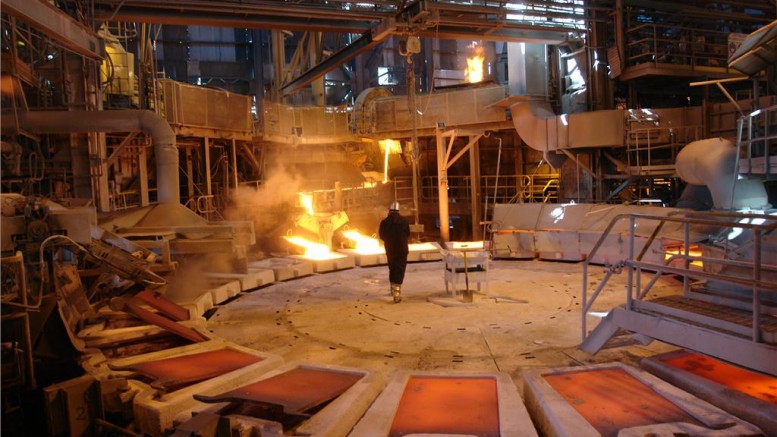The following is an edited release from the International Copper Study Group (ICSG) showing preliminary data for world copper supply and demand for 2018. For more detailed information, visit www.icsg.org.
Mine production
Preliminary data shows that world mine production is estimated to have increased 2.3% in 2018, with concentrate production rising 2.2%, and solvent extraction-electrowinning (SX-EW), 3.2%.
The increase in world mine production of 460,000 tonnes copper principally owed to constrained output in 2017 (mainly in Chile, Indonesia and the Democratic Republic of the Congo) and to an unusually low rate of overall supply disruptions in 2018. Besides the restart of Katanga’s 300,000 tonne-per-year copper mine in the DRC, no major copper mine started in 2018.
Production in Chile, the world’s biggest copper-mine producing country, increased 6% because output in February and March 2017 was restricted by a strike at Escondida — the world’s largest copper mine.
Indonesian concentrate output grew 5%, due to the fact that comparative output in 2017 was negatively affected by a temporary ban on concentrate exports that started in January and ended in April.
SX-EW production in the DRC increased 16% and Zambian mine output increased 8%, as a result of the restart of temporarily closed capacity in both countries.
After a strong increase over the last few years due to new and expanded capacity, output in Peru — the world’s second-largest, copper-mine-producing country — stabilized.
Although no major mine supply disruptions occurred in 2018, growth was partly offset by lower output in Canada (-10%) and the United States (-3%).
On a regional basis, mine production is estimated to have increased 10% in Africa, 3.5% in Latin America and 10% in Oceania, but declined 4% in North America, and remained essentially unchanged in Asia and Europe.
Refined production
Early data shows world refined production increased 1.5% in 2018, with primary production (electrolytic and electrowinning) increasing 2% and secondary production (from scrap) declining 1%.
World growth was constrained by an unusually high frequency of smelter disruptions and temporary shutdowns for technical upgrades and modernizations.
The main contributor to the growth in world-refined production was China, due to its continued expansion of capacity.
A 1.3% rise in Chile was a consequence of a recovery from 2017, when output was negatively impacted by a series of smelter maintenance shutdowns. However, despite this increase, Chilean output in 2018 was still 6% lower than in 2016, as it was also impacted by temporary smelter shutdowns, while undergoing upgrades to comply with the new environmental regulation.
Japanese output rose 7%, recovering from lower output in 2017, when a major smelter undertook extended maintenance.
Increases in SX-EW output in the DRC and Zambia also contributed to world refined production growth.
Overall growth was partly offset by a 34% decline in India’s output due to the shutdown of Vedanta’s Tuticorin smelter in April and declines in Germany, the Philippines and Poland, as a consequence of maintenance shutdowns and operational issues.
On a regional basis, refined output is estimated to have increased in Africa (10%), Asia (1%), Europe (1.5%), Oceania (5%) and Latin America (1%).
Refined usage
Preliminary data indicates that world apparent refined usage is estimated to have increased 2% in 2018.
Chinese apparent usage grew 5%, driven by a 20% increase in net refined copper imports. It is possible this development was influenced by a tightness in the availability of scrap in China.
Among other major copper users, demand increased in India, Japan, the U.S. and the EU, but declined in Russia, South Korea and Taiwan.
Preliminary data indicates that world ex-China usage was essentially the same.
Refined copper balance
Preliminary world refined copper balance for 2018 shows a 390,000-tonne deficit.
In developing its global market balance, ICSG uses an apparent demand calculation for China that does not take into account changes in unreported stocks (State Reserve Bureau, producer, consumer, merchant/trader, bonded). To facilitate global market analysis, however, an additional line item — refined world balance adjusted for Chinese bonded stock changes — is included in a related table that adjusts the world refined copper balance, based on an average estimate of changes in unreported inventories provided by three consultants with expertise in China’s copper market.
Lower growth in world refined production, as explained above, combined with strong Chinese apparent usage resulted in a 390,000-tonne deficit in 2018.
After adjusting the world refined copper balance for changes in Chinese bonded stocks, the market deficit was 450,000 tonnes.
Copper prices and stocks
Based on the average of stock estimates provided by independent consultants, China’s bonded stocks are thought to have declined 60,000 tonnes in 2018, compared to the year-end 2017 level. Bonded stocks increased 5,000 tonnes in 2017.
At the end of February, copper stocks held at the major metal exchanges (LME, Comex, SHFE) totalled 395,125 tonnes, an increase of 44,629 tonnes (+13%) from stocks held at the end of December 2018. Stocks were down at the LME (-5%) and Comex (-49%), and up at SHFE (84%).
The average LME cash price for February was US$ 6,278.20 per tonne — up 5.8% from the January 2019 average of US$ 5,932.02 per tonne.
The 2019 high and low copper prices through the end of February were US$6,546 per tonne (on Feb. 25, 2019) and US$5,811 per tonne (on Jan. 3, 2019), and the year average was US$6,096.87 per tonne (7% below the 2018 annual average).





Be the first to comment on "Facts ‘n’ Figures: Copper mine output rises 2.3% in 2018, says ICSG"